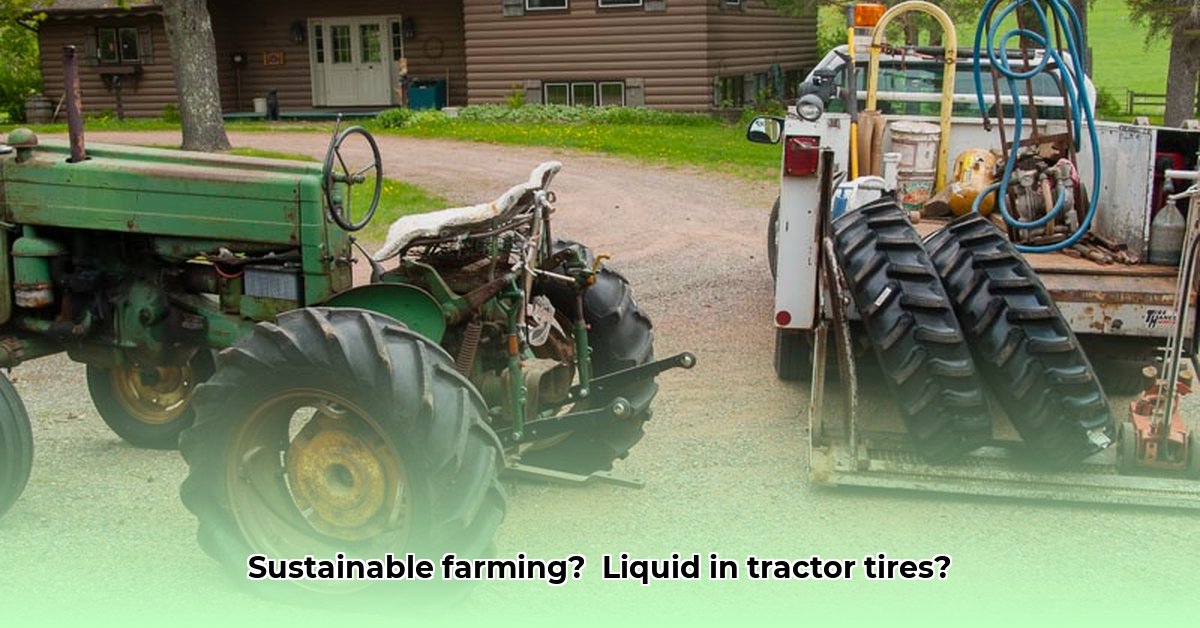
Choosing the right liquid ballast for your tractor tires significantly impacts your farm's efficiency, sustainability, and profitability. This guide compares various options, helping you make an informed decision based on your specific needs and climate. We'll outline the pros and cons of each liquid, factoring in cost, environmental impact, and operational considerations. For more detailed instructions on filling tires with water, see this helpful guide: water filling guide.
Understanding Liquid Ballast: Why It Matters
Liquid ballast offers several advantages over other ballasting methods:
- Improved Traction: Increased grip, especially in wet or muddy conditions, leading to safer operation and reduced fuel consumption. This translates directly to increased efficiency in fieldwork.
- Enhanced Stability: Greater tire weight stabilizes the tractor, minimizing the risk of rollovers, particularly on slopes or uneven terrain; increasing operator safety.
- Reduced Soil Compaction: Even weight distribution minimizes soil damage, preserving soil health and long-term productivity; crucial for sustainable farming practices.
Exploring Liquid Ballast Options: A Comparative Analysis
Several liquids can be used as ballast, each with distinct advantages and disadvantages. The optimal choice depends on your specific circumstances.
Water: The Economical, but Temperature-Sensitive Choice
- Pros: Inexpensive and readily available, making it the most economical option. Environmentally benign.
- Cons: Susceptible to freezing in colder climates, causing potential tire damage. Lower density necessitates larger volumes to achieve desired weight. A suitable option only for warm climates.
Beet Juice: A More Sustainable Alternative
- Pros: A byproduct of the sugar industry, enhancing sustainability. Offers improved freeze protection compared to water and provides adequate weight.
- Cons: More expensive than water. May attract wildlife, potentially creating additional farm challenges. Best suited for moderate climates with less risk of frost.
Antifreeze (Propylene Glycol): Protecting Against Freezing Temperatures
- Pros: Excellent freeze protection, even in extremely cold conditions. Higher density than water, requiring less volume for equivalent weight.
- Cons: Significantly more expensive than water or beet juice. While less toxic than ethylene glycol, it still requires careful handling and responsible disposal to minimize environmental impact. A costlier, but often necessary solution for cold climates.
Antifreeze (Ethylene Glycol): High Performance, but High Risk
- Pros: Superior freeze protection and high density.
- Cons: Highly toxic to humans and animals; poses significant health and environmental risks. Subject to strict regulations concerning use and disposal. Generally avoided due to its hazards. Only use with extreme caution and adherence to strict safety protocols.
Calcium Chloride: High Density, but Corrosive
- Pros: Excellent freeze protection and high density; suitable for extremely cold climates.
- Cons: Highly corrosive, potentially damaging tires and rims over time. Requires careful handling and proper disposal to minimize environmental impact. The use of inner tubes may be essential to mitigate corrosion.
Windshield Washer Fluid: Convenient, But Less Ideal
- Pros: Readily available and relatively inexpensive.
- Cons: Poor freeze protection and may contain potentially harmful additives unsuitable for long-term use in tires. Provides minimal weight and offers limited benefits. Not recommended for agricultural applications.
Crucial Factors in Ballast Selection: Climate, Soil, and Budget
The ideal ballast liquid depends on several interconnected factors:
Climate: Freezing temperatures rule out water and beet juice. Antifreeze solutions are necessary in colder climates, despite their increased cost and potential environmental concerns.
Soil Type: Heavier clay soils require less ballast than lighter, sandy soils. Over-ballasting can lead to increased soil compaction.
Budget: Water remains the cheapest option. More specialized and protective liquids carry increased investment costs.
Regulatory Compliance: Always check local regulations covering the use, handling, and disposal of different ballast liquids.
Choosing the Right Ballast: A Step-by-Step Guide
Assess Your Farm's Needs: Evaluate your climate, soil type, and budgetary constraints. Consider local environmental regulations.
Compare Ballast Options: Weigh the pros and cons of each liquid, considering cost, freeze protection, environmental impact, and potential risks.
Seek Expert Advice: Consult with an agricultural engineer, extension service, or experienced mechanic for tailored recommendations.
Plan for Disposal: Develop a responsible disposal plan for used ballast. This is crucial for minimizing environmental impacts.
Monitor and Maintain: Regularly inspect your tires and the surrounding soil for any issues. Address problems promptly.
Conclusion: Sustainable Ballasting for a Thriving Farm
Selecting the appropriate liquid ballast is vital for efficient and sustainable farming. Consider environmental impact alongside operational needs. Careful planning, informed decisions, and responsible disposal practices pave the way for a prosperous and environmentally conscious operation. Staying updated on the latest research and best practices will help refine your approach.